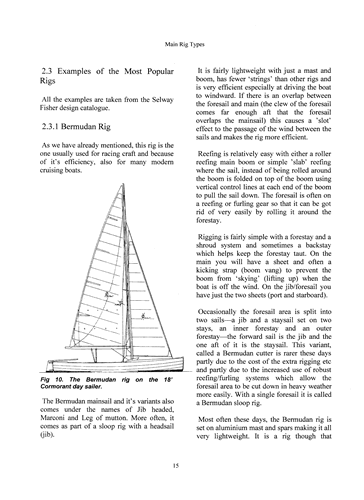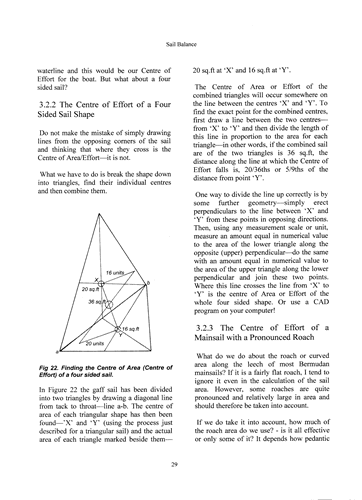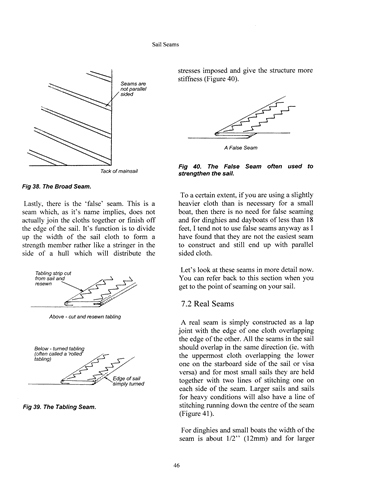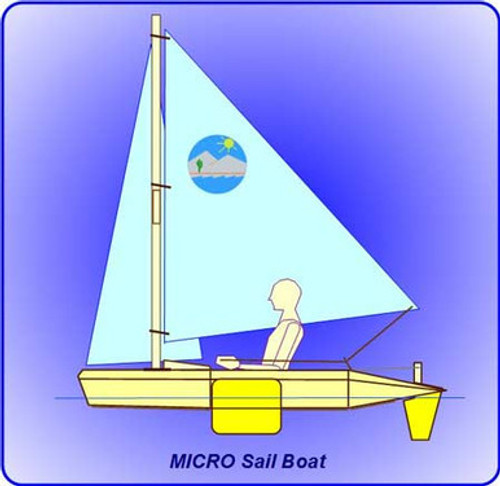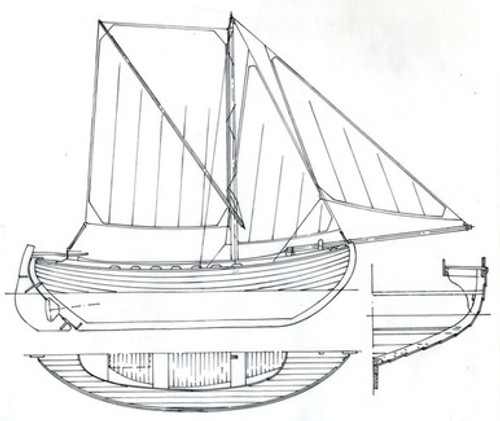This new manual incorporates our old "Manual of Sail Making for the Home Boatbuilder" but now also includes several new sections. These include a discussion of the most popular rigs used for dinghies, dayboats and yachts (traditional and modern), how to balance the rig with the hull of a boat (for those wanting to change rig), how to design and make a simple Junk Rig, a lengthened section on re-cutting (altering) existing sails (for those using 2nd hand sails from another design), positioning deck gear and fault finding, how to purchase new sails from a sail maker (including a list of UK sail makers) and a list of companies who sell sail making materials and tools.
A large part of the manual is still dedicated to making your own suit of sails - rather than being a mystery, the construction of a sail is broken down into it's different structural parts in much the same way as the hull structure of a boat with 76 clear diagrams showing the construction techniques used to make up the components of the sail. The chapters include a detailed look at the different stitches and seam constructions used, finishing techniques, step by step guides to the making of both Bermudan and Gaff/Gunter/Lug sails and Headsails. Also included is a section on the re-cutting of old sails and on fault finding. The whole manual will give the owner who already has a suit of sails, a better understanding of how his sails work and what may be wrong if he has a problem with them.
|
Sample Pages
Here is a review of this book by Rob Rohde-Szudy I have been slowly gearing up to make a set of "real" sails for my Bolger light schooner, from real sailcloth. Accordingly I have been reading all the books on sailmaking I can lay my hands on. Regrettably, the majority are voluminous tomes aspiring to be the definitive, exhaustive work on the topic. This encyclopedic breadth might be useful to the professional sailmaker who runs into a difficult problem. But for the average handyman who wants to make a sail, it is quite difficult to dig the applicable how-to out of the surrounding history and voodoo. Yes, voodoo indeed. Too many canvas books are afflicted with the idea that working with cloth occurs in a magical parallel dimension where measurements have no meaning and only long-bearded, pointy-hatted sages can contemplate the mysteries of where to place a seam. Thankfully we can turn to authors like Paul Fisher. Receiving this book is a different experience than we are accustomed to in North America. It ships from the UK, so shipping takes longer and costs more than usual. When the book arrived I was underwhelmed at first. My first glance revealed a slim self-published volume with several typos and no color photos. It actually sat on my shelf for a month or two before I looked again. I guess I should have gotten to it sooner, because it would have saved me a lot of time. In 53 pages Mr. Fisher tells the home sailmaker everything he needs to know, illustrated with crisp, explicit line drawings. After reading (or trying to.) some of the other books on the topic, this feat seemed impossible. But he can do it because of what he leaves out. First of all, there is no history. He focuses only on materials you will use today, and how to get the most out of them. No cotton, no flax, no square rigs. He addresses only the sail types common to modern homebuilt boats, including gaff and lug - vital information missing from many larger works. He also addresses only the size sails we commonly need. This work is not burdened with the monstrously strong constructions you will need for that five-tonner you'll never have time to sail. Best of all he removes the hocus-pocus. As the author points out in the introduction, if sailmaking was truly a black art, it would be impossible to use computers to both design and cut modern sails. We can do the same with tape measures and pencils, and he shows us how. What more can one ask? Well, maybe we could ask for some practical hints from someone who has made a lot of sails. Again, Fisher delivers. Who knew that when hand seaming, you should twist the thread after each stitch to keep it from unlaying itself? I have seen sail twine do this in my own stitching, but never has it occurred to me that the remedy would be so simple and obvious. Or that I wouldn't find it in the thicker books. In short, this work is exactly the kind of writing the do-it-yourselfer needs. No nonsense, no mystery, and straight to the point with useable how-to.
Rob Rohde-Szudy
|
Contents
Introduction
Chapter 1
Sail Theory
Chapter 2
Main Rig Types
2.1 General
2.2 Deciding on a Particular Rig
2.3 Examples of the Most Popular Rigs
2.3.1 Bermudan Rig
2.3.2 Gaff Sloop Rig
2.3.3 Gaff Cutter Rig
2.3.4 Gunter Rig
2.3.5 Lug Rigs
2.3.5.1 Standing Lug
2.3.5.2 Balanced Lug
2.3.5.3 Dipping Lug
2.3.6 Sprit Rig
2.3.7 Cat Rig
2.3.8 Leg of Mutton Rig
2.3.9 Chinese Junk Rig
Chapter 3
Sail Balance and How to Design for It
3.1 What is Sail Balance?
3.2 The Centre of Effort
3.2.1 The Centre of Effort of a Triangular Sail Shape
3.2.2 The Centre of Effort of a Four Sided Sail Shape
3.2.3 The Centre of Effort of a Mainsail with Pronounced Roach
3.2.4 Finding the Overall Centre of Effort of the Sail Plan
3.3 Finding the Centre of Lateral Resistance
3.4 The Balance of a Sail Boat
Chapter 4
What You Will Need to Make Your Own Sails
Chapter 5
Sail Cloth
5.1 General
5.2 Estimating Quantities and Obtaining Cloth
5.3 Sail Cloth Weights
5.4 Stretch Allowances
Chapter 6
Sewing
6.1 Machining
6.2 Hand Sewing
6.3 Methods of Stitching for Hand Sewing
6.3.1 Flat Seaming
6.3.2 Sticking Stitch
6.3.3 Running Stitch
6.3.4 Round Seaming
Chapter 7
Sail Seams
7.1 General
7.2 Real Seams
7.3 Broad Seams
7.4 False Seams
7.5 Tabling Seams
Chapter 8
Patches and Sail Fittings
8.1 Patches
8.2 Batten Pockets
8.3 Leech Lines
8.4 Headboards
8.5 Eyes & Slidesâthe Use of Webbing
Chapter 9
Finishing the Sail
9.1 Roping
9.2 Eyelets
9.3 Luff Wires
9.4 Cringles
Chapter 10
Mainsails
10.1 The Bermudan Mainsail
10.1.1 General Notes
10.1.2 Sail Shape
10.1.3 Making the Sail
10.2 Four Sided Sails including the Gunter
10.2.1 General Notes
10.2.2 Making the Sail
Chapter 11
Headsails (Foresails)
11.1 General
11.2 Making the Sail
Chapter 12
Junk Sails
12.1 General
12.2 Sail Shape
12.3 Battens
12.4 The Alternative Construction Method
Chapter 13
Re-Cutting Existing Sails (Altering Sails)
13.1 General
13.2 Decreasing the Size of a Bermudan Mainsail
13.3 Increasing the Size of a Bermudan Mainsail
13.4 Decreasing the Size of a Four Sided Sail
13.5 Increasing the Size of a Four Sided Sail
13.6 Decreasing the Size of a Headsail
13.7 Increasing the Size of a Headsail
Chapter 14
Positioning Deck Gear & Fault Finding
14.1 General
14.2 Positioning Jib Fairleads
14.2.1 How the Designer May Position the Foresail Sheet Fairleads
14.2.2 Correcting Badly Placed Foresail Fairleads
14.3 Fault Finding
Chapter 15
Purchasing New Sails (Including a List of UK Sail Makers)
Chapter 16
Sail Making Suppliers & Glossary of Terms
16.1 Sail Making Supplies
16.2 Sail Making Glossary



